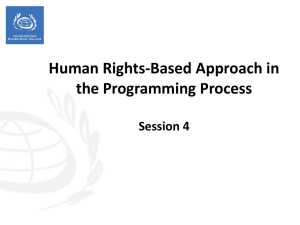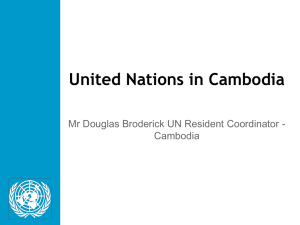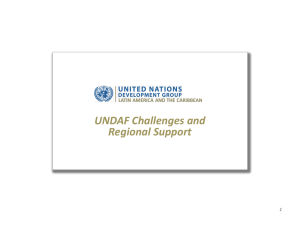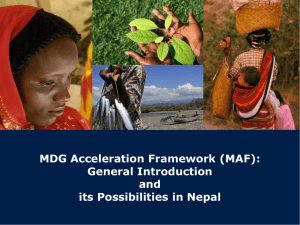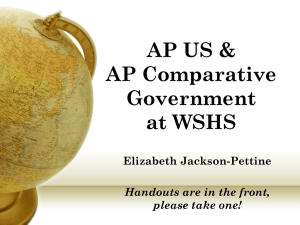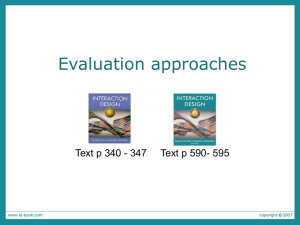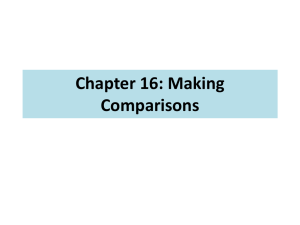Overview of UNDAF process and new guidance package
advertisement
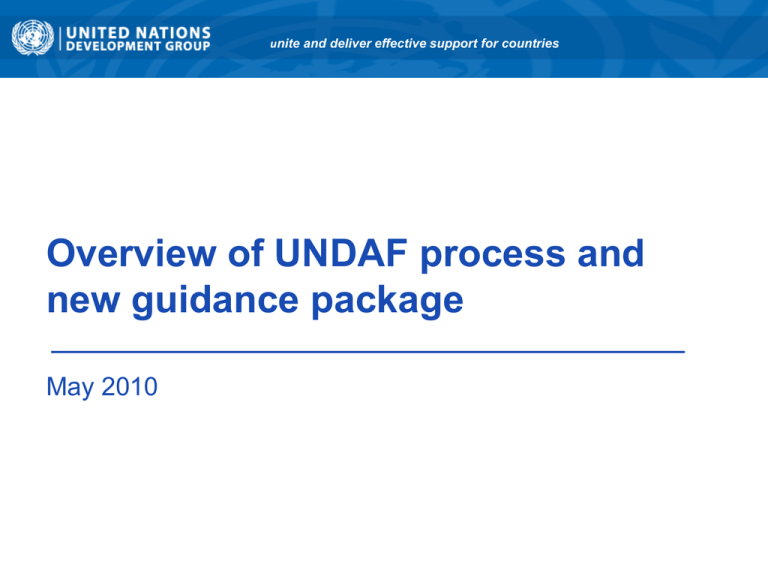
unite and deliver effective support for countries Overview of UNDAF process and new guidance package May 2010 Picking up from UN Reform Why new UNDAF Guidance? Demand from UNCTs to simplify UNDAF process TCPR and ECOSOC requirements Lessons learned from Delivering as One pilots and other countries Feedback Overview UNDAFs often lack Feedback Overview focus and strategic prioritization Process to prepare an UNDAF is a lengthy and inflexible Comparative advantage of the UN in-country is vague What is expected of the Simplified UNDAF Guidelines? Empower UNCTs to engage in programming processes in a flexible way that responds to local realities Closely align the UNDAF with national planning, as required by the TCPR 2007 Additional mechanisms for accountability and transparency among agencies Greater coherence at the operational level Lighter process is a timely input for the 46 UNDAF roll-out countries in 2010 Any questions until now? The three parts of the 2010 UNDAF Guidance Package UNDAF Progress Reporting UNDAF Action Plan Guidance UNDAF Guidelines & Technical Guidance Elements of Strategic Focus National Ownership Alignment with national development priorities Inclusiveness of UN system, including NRAs Integration of the five programming principles Mutual accountability for development results Programming principles & thematic guidance notes for country analysis and UNDAF The fab five: • HRBM • Gender equality • Environmental sustainability • Results-based Management • Capacity development Clarity of Roles and Responsibilities for an UNDAF • Resident Coordinator • UN Country Team • Regional UNDG Teams and their peer support groups UNDAF Guidelines Mandatory Steps 1. Road Map 2. Country Analysis 3. Strategic planning (Results Matrix) 4. M&E Road Road Map Map Purpose: Organize the UNDAF Process • Outline the UNDAF preparation process • Identify support needed from regional offices and HQs • Ensure a full consultative process throughout to ensure national ownership • Ensure full alignment to national planning cycle Road Map What’s new and important about the Road Map? • No prescribed calendar for the process (to closely align UNDAF with the national processes and calendar) • No prescribed mechanisms for engagement with partners (example, no JSM) • More flexibility Remember: Do not underestimate the time needed for the common programming process. Group Work What are the 3 main issues you are facing in developing your UNDAF? A Country Analysis will: Strengthen country analytical capacities to develop highquality development objectives Country Analysis 1. Review of existing analytical process & products to determine they meet minimum quality standards 2. Conduct country analysis: (a) Participation in Gov-led analytical work (b) Complementary UN-supported analytical work focusing on gaps in existing analysis (c) A full Common Country Assessment 3. Map UNCT work in country and determine UNCT comparative advantages Country Analysis What’s new and important about the Country Analysis? Flexibility to summarize findings from recent up-to-date data sources and analytical processes Flexible timeline allows UNCTs to decide when to undertake the analysis Remember: Strong country analysis is more likely to lead to a strong UNDAF and ultimately strong agency programming. Strategic Planning will… Develop results against national priorities and how you will achieve them Strategic Planning 1. Conduct a Strategic Prioritization Exercise 2. Select priorities and outcomes (use as a guide 5 programming principles, MfDR principles & UN comparative advantages 3. Develop an UNDAF Results Matrix 4. Obtain feedback on Results Matrix (UNCT self-assessment, Gov feedback, PSG review) 5. Signing of the UNDAF w/ Government Strategic Strategic Planning Planning What’s new and important in Strategic Planning? • Only one outcome level in the UNDAF results matrix • Simplified results matrix that integrates the M&E framework • Option to keep UNDAF at strategic outcome level (there are two options for developing your UNDAF results matrix) Results Matrix Results Matrix Results Matrix Results Matrix Monitoring and M&EEvaluation… Tracks UNDAF Results M&E Monitoring and Evaluation are distinct and required Basic elements: • Develop the mandatory M&E Plan • Conduct the mandatory UNDAF annual review process with Government • Produce a single UNDAF progress report per cycle • Conduct evaluation of the UNDAF M&E What’s new and important about M&E? • Annual review is mandatory (must be documented) • One progress report per cycle (frequency determined by UNCT). Mid-term reviews not necessary. • Flexibility: Align annual review with national review. Link UNDAF evaluation with national evaluations; modalities flexible. Any questions until now? What’s New in the UNDAF Guidance Package? UNDAF Progress Reporting UNDAF Action Plan Guidance UNDAF Guidelines & Technical Guidance UNDAF Action Plan Key Features: • Complements UNDAF with a common operational plan • Specifies strategies used to deliver UNDAF results • Replaces Country Programme Action Plans • It’s voluntary UNDAF Action Plan Implications: Lower transaction costs for national counterparts Less risk of fragmentation More coherence in UNDAF implementation UNDAF Action Plan Contents of the UNDAF Action Plan 1. Signature page 5. Resources and RMS 2. Partnership, values and principles 6. Communication 3. Implementation strategies 4. Management and Accountability Arrangements 7. M&E 8. Commitments of the Government 9. Other provisions 10.UNDAF Action Plan Matrix UNDAF Action Plan Matrix A Country Analysis -> UNDAF 1a -> CPDs -> CPAPs/Ag. Programmes -> AWPs Implications: Feedback Overview But: • picture of UN strategic intention, with no details • fosters UN strategic dialogue B • possible disconnect with UNDAF • less agencies’ engagement & ownership • governments’ transaction costs Feedback Country Analysis -> UNDAF 1a -> CPDs Overview -> UNDAF Action Plan-> AWPs Implications: • replaces CPAPs/Ag programmes But: • greater coordination efforts • brings together programming, budgets and oper-s • fosters mutual accountability • reduces transaction costs for gov’ts • agencies’ buy-in is critical • strengthened RCO capacity • programming process sequence C Country Analysis -> UNDAF 1b -> CPDs -> CPAPs/Ag. Programmes -> AWPs Implications: • most familiar and “comfortable” • clear linkage between UNDAF & ag. programmes D But: • “moderate” fragmentation • transaction costs for gov’ts Country Analysis -> UNDAF 1b -> CPDs -> UNDAF Action Plan-> AWPs Implications: • ensures the details for “operationalization” • Gov’t signs only two UN documents • Gov’t and partners review only one UN report But: • most labor intensive What’s New in the UNDAF Guidance Package? UNDAF Progress Reporting UNDAF Action Plan Guidance UNDAF Guidelines & Technical Guidance UNDAF Progress Reporting Main Features: Responds to GA and ECOSOC resolutions for RC/NCTs to report progress on UNDAF Provides Standard Operational Format (reporting template) for developing UNDAF progress report at the outcome level Stipulates that UNCTs must issue at least one UNDAF progress report per UNDAF cycle Guides UNCTs on how to conduct the mandatory UNDAF annual review UNDAF Progress Reporting Implications: • Standard Operational Format is a tool to enhance mutual accountability • Maximizes use of existing data and reporting systems • Provides format for reporting and describes how to conduct an annual review • Opportunity for advocacy Summary What does it all add up to? Strategy and Support for UN Country Teams Preparing UNDAFs in 2010 Process Road Map Regional UNDG Team - RC/UNCT meeting UNDAF Regional Workshops Country Analysis Strategic Prioritization HRBA-RBM Workshop (strengthen analytical and planning skills) Strategic Planning Retreat (identify/ validate priorities for the UNDAF and UNCT comparative advantages) UNDAF Finalization - Seek stakeholder endorsement of UNDAF priorities and results - Align agency programming with UNDAF results In-Country Road Map workshop(s) UNCT Capacity Assessment (stocktaking) Review of country analysis & UNCT analytical contribution Analysis of UNCT comparative advantages Results Road Map for UNDAF preparation - Steps and milestones - Support needs from regional offices and headquarters - Mapping national planning process & stakeholders - Prelim. identification of major national challenges and UNCT comparative advantages Support Roles Country Analysis Report(s) - UNDAF Results Matrix and M&E plan (draft) - Gaps in country analysis identified - UNDAF Action Plan Results and Resources Framework (optional – draft) - Stronger understanding of major national challenges - Potential joint programmes identified - UNCT comparative advantages identified - UNCT comparative advantages validated All the above with stakeholder engagement - Implementing partners identified UNDAF - - Signed (end March yr5) UNDAF Action Plan (draft – if opted for by UNCT) Draft Agency Plans - Next steps to engage stakeholders, seek endorsement à UNDOCO: Policy guidance, overall strategy for support, respond to country requests for support, consolidate lessons, financial support à Regional UNDG Team: Strategic advice and coordination à Regional Peer Support Group (PSG): Engage in planning process, provide technical support and oversight of quality à UNSSC (Staff College): Training methodology, train trainers and resource persons, prepare and support teams for UNDAF workshops Lead: RC/UNCT Suggested Timeline Review UNCT Capacity Assessment for UNDAF implementation Lead: Region Lead: UNDOCOUNSSC By October 31, yr 4 By Dec 31, yr 4 Support to UN country teams • Regional UNDG Team: Guidance on regional context • Regional Peer Support Group (PSG): Provide technical support and oversight of quality • UNSSC (Staff College): Training methodology, train trainers and resource persons, prepare and support teams for UNDAF workshops • UNDOCO: Policy guidance, overall strategy for support, respond to country requests for support, consolidate lessons, financial support UNDAF Guidelines Flexibility and Coherence UN country teams can follow through on each step of their UNDAF in a flexible way to respond to their national context. unite and deliver effective support for countries Thank you Unite and Deliver Thank You
